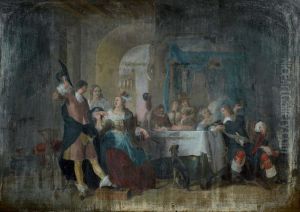Hyeronimus Janssens Paintings
Hyeronimus Janssens, also known as Hieronymus Janssens or Jansens, was a Flemish painter born in Antwerp in 1624. He is primarily recognized for his work as a genre painter and is commonly referred to as the 'Architect of the Dance.' Janssens' work predominantly featured elegant ballroom and court scenes, reflecting the aristocratic life and leisure activities of his time. His paintings are characterized by their dynamic composition, the fine detailing of the figures' attire, and the lively atmosphere he managed to capture.
Janssens received his artistic training in the studio of Christoffel Jacobsz. van der Lamen, a painter who was also known for his genre scenes and who had a significant influence on Janssens' style. After his apprenticeship, Janssens became a master in the Guild of Saint Luke in Antwerp in 1644, indicating that he had developed his skills sufficiently to be recognized as a professional artist. He spent his entire career in Antwerp, which, during the 17th century, was a vibrant center of art and commerce.
Throughout his career, Janssens developed a niche for himself with his dance scenes. He also painted other subjects such as card games, concerts, and conversation pieces, which were also popular among the Flemish bourgeoisie and aristocracy. His works often included intricate architectural backgrounds, showcasing his skill at incorporating perspective and depth into his paintings, which added to the grandeur and realism of the scenes. Janssens' attention to detail, particularly in the depiction of luxurious fabrics and the interplay of light and shadow, made his paintings highly sought after.
Janssens' success as an artist was also reflected in his social status. He married the daughter of the painter Jan Brueghel the Younger, Paschasia Brueghel, in 1654, which connected him to one of the most prominent artistic families in Antwerp. Despite his connections and success, there are no known pupils or followers who continued his specific genre, and his style did not spawn a significant school of followers.
Janssens died in Antwerp in 1693, leaving behind a body of work that provides a window into the leisurely pursuits of the upper classes in the 17th-century Flemish society. Although not as widely known today as some of his contemporaries, his work is appreciated for its elegance and vivacity and can be found in various art collections and museums across Europe.

